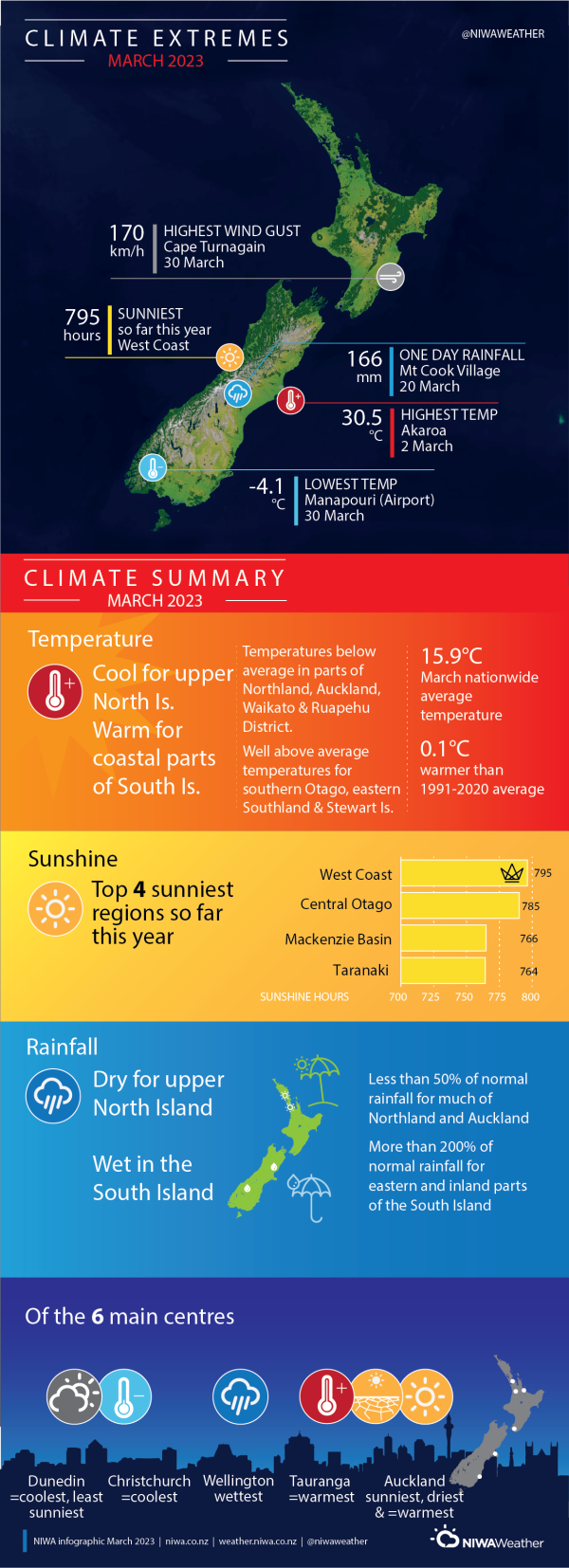Dry and cool for upper North Island, wet for South Island
|
Rainfall |
Below normal rainfall (50-79% of normal) or well below normal rainfall (<50% of normal) was observed in Northland, Auckland, northern Waikato, coastal Bay of Plenty, Gisborne, northern Wairarapa and Nelson. Above normal rainfall (120-149% of normal) or well above normal rainfall (>149% of normal) was observed across much of the South Island, as well as Wellington, southern Wairarapa, Whanganui and Taranaki. |
|
Temperature |
Temperatures were below average (0.51-1.20°C below average) in parts of Northland, Auckland, Waikato, and the Ruapehu District. Temperatures were above average (0.51-1.20°C above average) in parts of Tasman, Marlborough, coastal parts of Canterbury south of Ashburton, Dunedin, and central and southern Southland. Temperatures were well above average (>1.20°C above average) for southern Otago, eastern Southland, and Stewart Island. |
|
Soil Moisture |
At the end of March, soil moisture levels were above normal for most of the North Island, eastern parts of Canterbury north of Ashburton, and parts of Otago and Southland. Soil moisture levels were below normal in northern parts of Northland, and Nelson. Elsewhere, soil moisture levels were mostly near normal. |
Overview
March was characterised by lower than normal mean sea level pressure (MSLP) in the Aotearoa New Zealand region, with numerous low pressure systems tracking in from the Tasman Sea during the month. After three consecutive years of La Niña, ENSO neutral conditions developed during March, and much of the country observed more frequent westerly winds than normal. Sea surface temperatures in New Zealand’s coastal waters remained higher than average during March, and were the warmest on record for the month of March to the east of the South Island. The Southern Annular Mode (SAM) became strongly negative during the first two weeks of March, and the index reached as low as -2.5, which was the lowest March daily value since 2017, and 2002 prior to that.
March rainfall was below normal (50-79% of normal) or well below normal rainfall (<50% of normal) in Northland, Auckland, northern Waikato, coastal Bay of Plenty, Gisborne, northern Wairarapa and Nelson. In contrast, rainfall was above normal (120-149% of normal) or well above normal (>149% of normal) across much of the South Island, as well as Wellington, southern Wairarapa, Whanganui and Taranaki.
March temperatures were below average (0.51-1.20°C below average) in parts of Northland, Auckland, Waikato, and the Ruapehu District. Temperatures were above average (0.51-1.20°C above average) in parts of Tasman, Marlborough, coastal parts of Canterbury south of Ashburton, Dunedin, and central and southern Southland. Temperatures were well above average (>1.20°C above average) for southern Otago, eastern Southland, and Stewart Island. This was despite an unseasonable cold snap later in the month which delivered snow to low elevations, and saw numerous locations set record or near-record low daily maximum and daily minimum temperatures (see Highlights and extreme events section for further details). The nationwide average temperature in March 2023 was 15.9°C. This was 0.1°C above the 1991-2020 March average from NIWA’s seven station temperature series which begins in 1909.
Further Highlights:
- The highest temperature was 30.5°C, observed at Akaroa on 2 March.
- The lowest temperature was -4.1°C, observed at Manapouri on 30 March.
- The highest 1-day rainfall was 166 mm, recorded at Mt Cook Village on 20 March.
- The highest wind gust was 170 km/h, observed at Cape Turnagain on 30 March.
- Of the six main centres in March 2023, Auckland was the sunniest and driest, Auckland and Tauranga were the equal-warmest, Wellington was the wettest, Christchurch and Dunedin were the equal-coolest, and Dunedin was the least sunny.
- Of the available, regularly reporting sunshine observation sites, the sunniest four locations so far in 2023 are West Coast (795 hours), Central Otago (785 hours), Mackenzie Basin (766 hours), and Taranaki (764 hours).
Download:
- Climate Summary March 2023 [PDF 435 KB]
- Climate Statistics March 2023 [PDF 156 KB]


